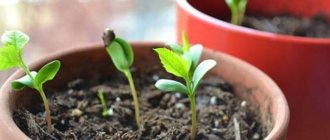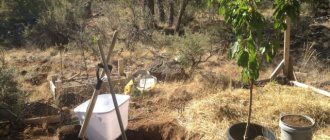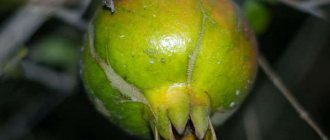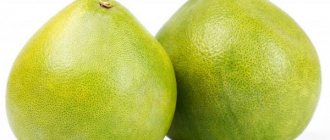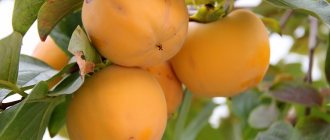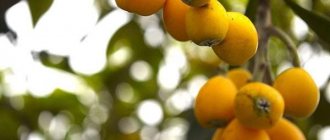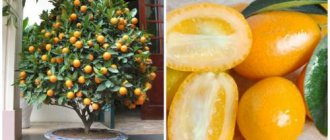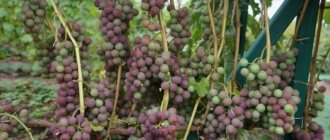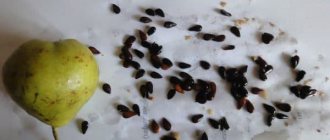Author of the article
Daria Vorontsova
Reading time: 15 minutes
AA
For those who are concerned about the main question, I’ll give you the answer right away: it’s quite possible to grow lychees from seeds at home. You just need to use my detailed instructions!
The article tells you how to grow lychee from a seed, how to properly care for a seedling and what to do to get tasty fruits.
In the middle zone, the cultivation of lychee is still gaining popularity among gardeners.
You can find seedlings only in certain specialized nurseries. Therefore, many hobbyists successfully grow it themselves.
Lychees in natural nature
The places where lychee naturally grows are the southeastern region of China, India, the countries of Southeast Asia and Africa. The most favorable climate for this plant is a dry subtropical climate with mild winters. In tropical conditions the tree grows well, but stops producing fruit.
In nature, the height of the lychee tree can reach 15 meters. There are specimens up to 30 meters in length. In apartment conditions, lychee growth is limited by the size of the pot. As a rule, the plant grows no higher than 2 meters.
Lychee begins to bloom at 7-8 years. White flowers without petals are collected in inflorescences in the form of panicles, which have a delicate delicate aroma.
Lychee fruits are covered with a thin, dense pink shell. The pulp is jelly-like and white. It has a sweet and sour taste, reminiscent of the taste of currants and strawberries at the same time. Cross pollination is necessary for fruit set.
Types and varieties of lychee
There are about 100 varieties of lychee, all of which produce edible fruit. The most common are:
- Muzaffarpur;
- Purby;
- China;
- Late Seedles.
Their fruits differ in size and appearance. The pattern on the skin of the fruit can be either smoother or lumpy, uneven, and very pronounced. Some fruits are small in size, others can be almost the size of your palm. The taste of the fruits of different varieties does not differ significantly, but some may be sweeter than others.
The color of the peel varies from light pink to almost crimson. It depends not so much on the variety, but on the degree of ripeness of the fruit. Unripe berries have a brownish-green surface.
Preparation of materials
To get the desired result, you need to prepare in advance the necessary materials for planting the plant.
How to choose seed
When choosing fruits, it is important to choose ripe fruits without dark spots on the skin, dents or signs of mold.
Helpful information
Daria Vorontsova
Amateur gardener. He is interested in growing various greens at home.
Lychee is a perishable product. Therefore, it is not recommended to store the extracted seeds. It is better to buy and remove seeds no earlier than 5-6 days before planting.
It is recommended to plant several seeds at the same time. Subsequently, 1-2 of the strongest and most robust seedlings are left.
How to prepare a bone
The extracted bone is washed to remove any remaining pulp and soaked for 24 hours in a weak solution of potassium permanganate. There is no need to dry the seed and open the peel.
How to choose soil
Light, loose soil with plenty of nutrients is best for lychee. It is allowed to grow the plant in universal soil or a mixture of soil and peat in a 1:2 ratio.
Adding mycorrhizal preparations to the soil has a good effect on the immunity and development of the plant. They contain fungal cultures. Thanks to the symbiosis of plants and fungi, the root system better absorbs nutrients from the soil.
Planting seeds in garden soil is not recommended due to the high probability of infecting the plant with fungal and viral diseases.
Which container is suitable?
Like all tropical plants, lychee is characterized by active growth of the root system. Therefore, for sowing seeds it is better to take small pots with a volume of at least 300 ml.
Planting in small pots or plastic cups will result in plants having to be replanted prematurely, which can damage the delicate seedlings.
What is lychee fruit, what does it look like, where is its homeland: description
In Southeast Asia, Chinese lychee is the most common fruit. Frequently encountered names, in addition to those already mentioned, are liji, laisi, lisi, Chinese plum.
| Use fresh seeds for planting. Because they quickly lose their viability. |
| Prepare a small container with drainage holes to drain excess water. At the bottom, arrange drainage from expanded clay or broken red brick at ¼ height. |
| Prepare a nutrient substrate from garden soil and peat in a 2:1 ratio. Bury several seeds 1 cm into the ground and water. |
| Germination requires a greenhouse effect, so the container must be covered with a plastic or glass jar. If a suitable container is not found, build a frame and cover it with cellophane. Seeds sprout after 2-3 weeks in a dark and very warm place, for example under a radiator. |
| The temperature should be within 35 ºС. As the seeds sprout, make sure the soil is always moist. Daily short-term ventilation of the greenhouse is mandatory. |
| After the sprouts appear, the greenhouse is removed. The container is placed in a bright place with an air temperature of 25 ºС. When the plants get stronger, they need to be planted in permanent containers. |
- From May to September, lychee grows actively and requires abundant watering.
- From September to the end of February it has a period of rest. Watering at this time is reduced.
Ageratum: care features and growing at home
Since the plant has a number of beneficial properties, many people grow it as a houseplant. However, to do this, the following aspects should be taken into account:
- air temperature in the living room;
- proper watering regime;
- soil composition for planting.
The process of how to grow a lychee tree at home begins with acquiring the fruit itself. The ripe fruit is cut, removing the seed from it. After this, it is thoroughly washed and planted in prepared soil.
When the seed is already in the ground, the container is covered with a plastic bag to create a greenhouse microclimate. Then the container is placed in a warm place and the first leaves are expected to appear. As a rule, after 2 or 3 weeks the first greenery rises from the soil. During this period, the film is removed so that the plant can actively develop. It is from May to early September that the lychee tree needs to maintain the correct temperature regime, which does not exceed 35 degrees Celsius.
After the formation of green shoots, they need to be watered moderately every day. This creates conditions reminiscent of the natural environment in which the lychee tree grows. Over time, the seedlings will rise above the soil up to 20 cm in height. From this moment, the root system of the plant begins to develop, which slows down the growth of the above-ground part of the fruit.
In mid-latitudes, lychee is considered a strange plant; therefore, it is quite difficult to buy seedlings of such a crop in a garden pavilion. However, you can try to grow such a tree from a seed indoors. To do this, purchase a ripe fruit that has a strong odor, translucent juicy pulp and a red skin.
The tissue of the swollen seed must be removed, after which it is planted in a pot with a drainage hole at the bottom. At the bottom of the pot, first you need to lay out a drainage layer of expanded clay, after which it is filled with flower soil mixture. The seed needs to be buried only 20 mm into the substrate. When planting several seeds, the chances of a seedling appearing increase several times.
When the seed is planted, the substrate in the container must be moistened with lukewarm water. The seed should germinate at a temperature of 25 to 30 degrees; it is very important to ensure that the substrate in the pot is always slightly damp. The first seedlings should appear in about 7–30 days, but this may happen later.
After the emerging seedling grows its first light red leaf blades, the container should be moved to a sunny windowsill, while the plant should be protected from direct rays of the sun. The plant is transplanted into a larger pot when it has 4 or 5 leaves.
The tropical, fruit-bearing lychee tree is a plant that can grow at home on a windowsill. Under natural conditions in a garden, trees can grow up to 25-30 meters; at home, the height reaches a maximum size of 2.5 meters, but more often it does not even reach such parameters. This allows it to take up little space while growing indoors.
To grow lychees from seeds at home, seeds from fruits purchased in the store are suitable; by following certain rules, you can ensure their 100% germination. The conditions necessary for seed germination are as follows:
- A warm room with humid air, reminiscent of the rainy season in the tropics.
- Constantly but moderately moist soil.
- After planting the seed, the air temperature in the room should not be lower than 25-30°C.
- Until the first leaves appear, keep the pot in a dark place, then provide sufficient lighting, but exclude direct sunlight.
Having studied the information on how to propagate lychees and how to grow a tree from a seed at home, prepare the necessary conditions and purchase the necessary containers, soil and fertilizers. Prepare the seed removed from the fruit for planting by wrapping it in a damp cloth, leaving it like that for a week, periodically sprinkling it with water to maintain moisture.
To plant a swollen seed, take a pot or container that has drainage holes, place a layer of expanded clay on the bottom, and fill it with nutritious, loose soil (with the addition of peat). It is safer to plant several seeds at once, deepening them by 1.5-2 cm, filling them with water until the soil is completely wet and excess moisture flows out through the drainage.
To increase your chances of growing a tree from seed, here are a few tips on how to germinate lychee seeds:
- Before lowering the swollen seed into the soil, lightly prick it, this will make it easier for the sprout to break through.
- Don't deepen the bone too much.
- Immediately after planting, use soft, warm water for watering.
- Place a small pot or container, covered with film, in a dark, warm place, preferably near a heating device.
- Check the condition of the soil daily, moisten if necessary, avoiding both drying out and stagnation of water.
- After the first stem appears, remove the film and move the container to a slightly shaded place.
- When 3-5 leaves appear, transplant the plant into a larger pot, place it on the windowsill, without exposing the tree to hot sunlight, water moderately.
Having decided to grow an exotic tree in your home, bought a fruit in a store and removed the seed from it, you need to know how to properly plant a lychee seed in the ground. Before growing lychee from a seed at home, make sure that the fruit chosen for its extraction is fully ripe, has a red skin and a strong aroma; only in this case can you count on success.
Some gardening enthusiasts, having purchased exotic fruits in supermarkets, try to grow small ornamental plants from them in their living space. Having completed the necessary agrotechnical techniques, you can grow a homemade lychee tree from a seed. When growing lychees from seeds, you should be patient; the process is slow; during the first six months, the grown seedling will produce only 2-3 leaves.
Lychee can also be called Chinese cherry, Chinese plum, Chinese grape. From a seed planted at home, a beautiful, ornamental plant will grow, evergreen with glossy, pointed, long leaves, with a neat rounded crown, which must be formed in the first year of life. The tree has a powerful root system, so it should be transplanted three times into a larger container before the age of three.
Lychee trees planted vegetatively from cuttings bear fruit best; they carry the genetic characteristics of this species. Fruiting of lychee planted from seed is more difficult to achieve, but if you provide the plant with high humidity in the room and elevated temperature, that is, create almost tropical conditions, there is a possibility of fruit appearing.
The crown should not be severely pruned; it will prevent the appearance of flower panicles; pruning is done only at the first stages of development. The lychee tree needs cross-pollination. In order for flower buds to form and develop, it is necessary to provide a slight seasonal temperature fluctuation (moisture and warmth in summer, a relative decrease in temperature in winter). Fruiting can occur in 6-10 years of plant life.
When the tree begins to take root and rise above the ground, it needs to be provided with enough light. The ideal place for it is the windowsill of a large window. It is important that the plant has access to light 12 hours a day. In winter, wise gardeners use artificial lighting.
Lychee planting rules
Is it necessary to germinate the seed in advance?
The prepared seed can be germinated in two ways:
- by soaking;
- in the substrate.
For the first option, you will need a clean cotton cloth and a shallow container. The prepared seeds are wrapped in a cloth moistened with water, placed in a container and put in a warm place.
Seeds must be monitored regularly. Do not allow the fabric to dry out. Excess moisture is also harmful to the seeds.
As a rule, the first sprouts appear 6-7 days after soaking the seed. To speed up the process, you can pre-treat the seeds with a solution of Epin or Zircon.
In the second option, the planting pot is filled with disinfected substrate. For this you can use coconut fiber, vermiculite or agroperlite. The substrate is moistened with water and the seeds are laid out on its surface, slightly buried. Cover the container with cellophane and put it in a warm place. When using this method, you can expect sprouts to appear in 10-14 days.
Which option for sprouting lychee seeds do you prefer?
Soaking in substrate
Landing in the ground
A drainage layer 1/4 of the pot high is poured onto the bottom of the container. Pour the prepared soil mixture.
The sprouted seed is placed horizontally in the soil to a depth of 1.5 cm. The sprout is covered with cellophane or glass and placed in a sunny place.
Helpful information
Daria Vorontsova
Amateur gardener. He is interested in growing various greens at home.
If several seeds are germinated, then picking should be done as early as possible, since the root system grows quickly and intertwines.
Rules of care
Lychee is an unpretentious plant and feels quite good in an ordinary apartment. It is only important to follow certain rules when planting and caring for this tropical plant.
Watering
Lychee needs regular watering and irrigation. The regularity of watering depends on the ambient temperature. In hot and sunny weather, the plant is watered daily, while avoiding stagnation of moisture in the soil. In winter, the frequency of watering is reduced to 1 time every 2-3 days.
Daily irrigation of foliage has a good effect on the plant. Spraying can be done 2 times a day in the morning and evening.
Watering and irrigation are carried out with warm, settled water. Cold water is detrimental to lychee.
To maintain an optimal microclimate, you can place a humidifier near the container with the plant.
Temperature
Like most other plants, lychee does not like direct sunlight or drafts.
It is better to install the container with the seedling on the side of the apartment where the sun appears in the afternoon.
Lighting
The lychee tree is a light-loving crop. Throughout the year, it is necessary to maintain at least 12 hours of daylight.
In winter, the plant is illuminated with phytolamps.
Top dressing
The first feeding is carried out after the appearance of the third true leaf. Phosphorus preparations are used as fertilizers.
After ten months, re-feeding is carried out. This time they use nitrogen fertilizers.
Subsequently, fertilizing is carried out once every two years in the summer with potassium phosphate fertilizers. All fertilizers are introduced into moist soil in the concentration specified by the manufacturer.
Transfer
Picking is done when the first two true leaves appear. As a rule, this happens in the second week after the first shoots. The sprouts are carefully separated from each other and placed in separate containers.
The first transplant is carried out when the plant reaches at least 30 cm in height and has 6 true leaves.
When transplanting, select a container slightly larger in volume. Completely renew the drainage layer and soil mixture. The roots of the plant are carefully examined. Broken roots with signs of rot are removed. You can wash the root system with a weak solution of potassium permanganate to prevent fungal diseases.
After transplantation, the plant is watered with warm water and placed in a bright place, avoiding direct sunlight. The next transplant is carried out when the roots of the plant occupy the entire volume of the pot.
Trimming
Experts do not recommend getting carried away with pruning the plant. Too frequent correction of the crown shape can lead to disruption of flowering processes.
It is better to limit yourself to sanitary pruning. It includes removing diseased and weak shoots and shortening branches that are too long. This procedure is best carried out in winter.
What to do if lychee does not grow?
To make growing lychee a joy, you will have to work hard. Pests often appear on tree branches that need to be dealt with promptly, including scale insects, spider mites, and common aphids. To remove parasites from lychee, the part above the ground will have to be thoroughly treated with a sponge with a solution of liquid soap, and then rinsed with running water after ten minutes.
If everything is done according to the rules, then the pests die, but otherwise you will have to resort to the help of professional insecticides. It is strictly forbidden to use such store-bought ones when flowers or fruits appear on the lychees.
If the plant stops growing, you should add soil from under an adult lychee to the pot, but this is difficult to do, since it is not always available. The apple of paradise will never fully grow if there is no mycorrhiza in the soil, that is, a special symbiotic type of fungus. This fungus can help the lychee to form microvilli around the root so that it can feed properly. It can be purchased at a specialty store or transplanted from pots of coniferous or citrus crops.
It is strictly forbidden to heat the acquired soil layer, as it can kill the beneficial fungal spores necessary for symbiosis.
If the shoots do not grow, then vermiculite will have to be added to the soil at a rate of two to one, which ensures active growth. If you want to get low trees, but with improved prospects (the number and quality of oval leaves), then it would be better to take soil from under an old pine tree.
Common mistakes in care
The most common mistake gardeners make when growing lychee is too much moisture in the soil. Rotting of the root system should be avoided. If this happens, it will be very difficult to save the plant. The problem can be identified by the appearance of dark spots on the leaves and trunk of the tree.
Drying leaves indicate a lack of light or poor temperature conditions.
It often happens that young seedlings are not able to extract nutrients from the soil. Despite the gardener's best efforts, they look pale and weak. This problem can be solved by adding mycorrhizal preparations to the soil. They can be added to the soil immediately before planting or to an already grown seedling. The table below provides a description of the most suitable drugs.
| Name | general description | Usage |
| KINFIX BRB-T16 | Contains 4 strains of fungi of the Glomeromycetes species. Improves soil composition, helps strengthen the root system. | Placed in the soil when planting seeds or used as root feeding |
| SuperROOT | Contains 7 strains of fungi of the Glomeromycetes species. Forms a symbiosis with lychee roots, produces antibiotics, protecting the plant from rot, and improves root nutrition. | Place it in the soil under the seed as a root seed when replanting the plant. |
| Glyocladin | Contains Trichoderma fungus strains. Improves soil structure, promotes root system development | Laying in the soil in the root zone of the plant. |
If the leaves turn yellow
Lychee is a non-deciduous tree that does not shed its leaves with the arrival of autumn. But it does not mean. That once covered with leaves, the tree will retain them for its entire allotted life. The leaves fall and gradually replace each other, but this happens unnoticed and should not frighten. Constant yellowing of the leaves, as well as their dying, should alert you. The reasons for such changes may be the following:
- Perhaps mineral fertilizing was carried out on plants affected by pests or weakened by disease.
- Often the leaves turn yellow due to improper, too much watering, which leads to rotting of the root system.
- Abundant watering is allowed only at high air temperatures; otherwise, it is important not to overwater the plant.
- The reason may be a lack of daylight during the winter months.
- Leaf fall can occur when air humidity is low or when the air temperature is not high enough.
Currently reading: Lychee fruit. What does it look like, I'll taste it
Although anyone can grow lychee if they wish, however, due to the characteristics of its root system, it cannot be overdried or overwatered.
Diseases and pests
Lychee growing indoors is rarely attacked by pests. Harmful insects can enter the plant along with poorly treated soil or from a nearby infected flower. Most often these are aphids, spider mites or whiteflies. You can notice their appearance by characteristic dots, thin webs and torn edges of leaves.
Aphid
Spider mite
Whitefly
If traces of insect activity appear on the plant, then, first of all, it is necessary to remove some of the pests mechanically. To do this, carefully wipe the leaves and trunk of the seedling with a soapy cotton cloth. After cleaning, you can treat the plant with one of the following preparations:
Spark;
Fitoverm;
Kleschevitis;
Fufanon-Nova;
Bitoxibacillin.
The treatment must be repeated at least 3 times with an interval of 5-7 days. To increase efficiency, each treatment can be carried out with a different drug.
Helpful information
Daria Vorontsova
Amateur gardener. He is interested in growing various greens at home.
Some pests, such as spider mites, can settle not only on the plant, but also next to it. Therefore, in addition to the infected plant, neighboring flowers, the window sill and the space under it are also treated.
The most common disease of lychee is fungal diseases. Their appearance is indicated by gray and reddish spots on the leaves. The cause, as a rule, is a violation of the watering regime.
If traces of a fungal infection appear on the plant, it must be treated as soon as possible. The soil must be completely replaced. The seedling is treated with Fundaz or any other antifungal agents.
How to choose a fruit for planting
Lychee seeds quickly lose their viability, so for planting you need to take a seed that has just been removed from the fruit. In order for the seed to germinate safely, you need to choose a high-quality fruit. Its signs:
- size not less than 3 cm;
- pink-red peel (lychees are too pale or darkened - unripe or overripe, their seeds may be infertile);
- no traces of mold, stains, cracks;
- elastic to the touch;
- fresh pleasant aroma (stale fruits have a too sweet smell).
For greater reliability, it is advisable to buy not one, but several lychees for planting, because The germination of seeds, as when planting an artichoke, is not one hundred percent.
When to expect the harvest
In order to obtain lychee fruits, the following conditions must be strictly observed:
- ambient temperature not less than 28 0C;
- daylight hours at least 15 hours a day;
- compliance with the watering regime;
- regular feeding.
- For fruit to appear, you need to pollinate the plant yourself with a soft brush.
Lychee begins to bloom at the age of three. And fruiting at home, as a rule, occurs only after 10 years.
This process can be accelerated by grafting a layer with a bud.
Conditions for growing lychee at home
Helpful Tips:
- soil type suitable for lychee: well-drained, sandy or loamy, acidity from 5 to 5.5;
- To prevent the plant from stretching, it needs good lighting at least 10 hours a day;
- the ideal temperature for growing lychee is +28-30 °C;
- the plant loves abundant and regular watering throughout the year and high air humidity (70–80%);
- as they grow, it is necessary to transplant lychees in time into containers appropriate to its size;
- Once every few months it requires feeding with liquid or granular mineral fertilizers.
Benefits of lychee
The main value of lychee is its low calorie content, high content of minerals and vitamins. The fruit contains a large amount of complex carbohydrates, fiber and pectins.
Lychee is rich in vitamin K, which affects the blood coagulation system. Contains selenium, magnesium, zinc and iron in large quantities.
Use in folk medicine
Lychee is widely used in oriental medicine. Extracts of this fruit are included in many dietary supplements. Regular consumption of lychee has multiple effects on the body:
- dilates blood vessels, reduces cholesterol levels;
- diuretic effect;
- reduces blood sugar levels;
- antioxidant effect;
- improves the functioning of the stomach and intestines;
- relieves fatigue and nervous tension;
- increases hemoglobin levels;
- increases sexual desire.
In China, lychee is successfully used as a drug for weight loss and cleansing the body.
External characteristics of the lychee tree
Lychee is an evergreen tree native to the tropics, where it reaches a height of ten to thirty-five meters. Having planted it at home, it is rarely possible to grow a tree up to two meters; usually it does not grow to that size.
Having a second name - Chinese plum, since it was first cultivated in China, lychee belongs to the Sapindaceae family. And today this plant from China has become widespread in America, Africa, Japan and is highly valued there for its tasty and healthy fruits.
The tree has a dense crown located on a smooth trunk with gray bark and pointed foliage. The first fruits can be obtained from a tree from the age of four in the form of small oval red fruits with a brown seed in white pulp. The fruit is covered with a pimply peel, which is easily removed from the jelly-like pulp with a pleasant aroma.
The fruit takes a long time to mature and becomes edible only four months after flowering. The lychee tree can only grow in the tropics and will not tolerate low winter temperatures, so in other climatic conditions it can only be grown in a greenhouse or at home, in a room.
